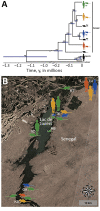Multihost Transmission of Schistosoma mansoni in Senegal, 2015-2018
- PMID: 32441625
- PMCID: PMC7258455
- DOI: 10.3201/eid2606.200107
Multihost Transmission of Schistosoma mansoni in Senegal, 2015-2018
Abstract
In West Africa, Schistosoma spp. are capable of infecting multiple definitive hosts, a lifecycle feature that may complicate schistosomiasis control. We characterized the evolutionary relationships among multiple Schistosoma mansoni isolates collected from snails (intermediate hosts), humans (definitive hosts), and rodents (definitive hosts) in Senegal. On a local scale, diagnosis of S. mansoni infection ranged 3.8%-44.8% in school-aged children, 1.7%-52.6% in Mastomys huberti mice, and 1.8%-7.1% in Biomphalaria pfeifferi snails. Our phylogenetic framework confirmed the presence of multiple S. mansoni lineages that could infect both humans and rodents; divergence times of these lineages varied (0.13-0.02 million years ago). We propose that extensive movement of persons across West Africa might have contributed to the establishment of these various multihost S. mansoni clades. High S. mansoni prevalence in rodents at transmission sites frequented by humans further highlights the implications that alternative hosts could have on future public health interventions.
Keywords: Biomphalaria pfeifferi; Lac de Guiers; Mastomys huberti; One Health; Rodentia; Schistosoma; Schistosoma mansoni; Senegal; Senegal River Basin; West Africa; children; definitive host; evolution; infectious diseases; molecular epidemiology; multihost system; parasites; reservoir; rodents; schistosomiasis; snail; transmission; zoonoses.
Figures

References
-
- World Health Organization. Schistosomiasis and soil-transmitted helminthiases: numbers of people treated in 2017. Wkly Epidemiol Rec. 2018;93:681–92. https://www.who.int/publications-detail/who-wer9350
-
- World Health Organization. Ending the neglect to attain the sustainable development goals: a road map for neglected tropical diseases 2021–2030. 2020. Feb [cited 2020 Feb 24]. https://www.who.int/neglected_diseases/Ending-the-neglect-to-attain-the-...
Publication types
MeSH terms
Grants and funding
LinkOut - more resources
Full Text Sources
Research Materials
Miscellaneous

